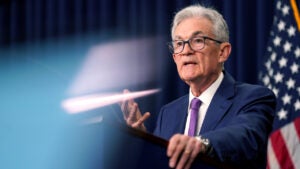The Federal Reserve’s board of governors, explained — who’s on it and what they do
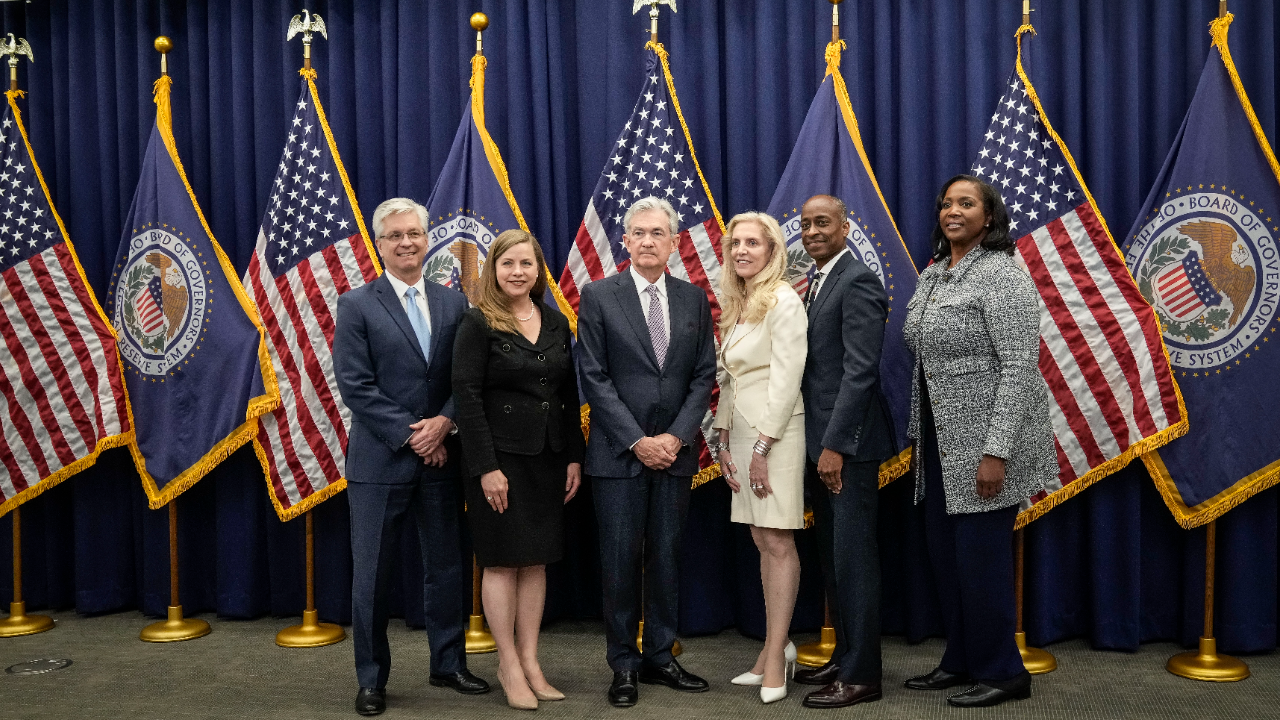
Key takeaways
- The Federal Reserve's board of governors is responsible for overseeing the broader Fed system, as well as supervising and regulating financial institutions.
- The board is made up of seven officials, including the chair and two vice chairs, who are appointed by the president and confirmed by the Senate.
- The board has a significant influence over monetary policy, as they have permanent voting positions on interest rate decisions and can create special programs to support the economy during times of crisis.
Every governing body has a leader. For the Federal Reserve, that’s where the board of governors comes in.
The board of governors is one of three key pillars making up the broader Federal Reserve System, along with the 12 regional reserve bank presidents and the Federal Open Market Committee (FOMC).
But unlike those other officials, the Fed’s governors have a more powerful influence over monetary policy. Most prominently, they have permanent voting positions on whether to raise, lower or maintain the benchmark interest rate that influences every financial product in a consumer’s portfolio: from credit cards, mortgage rates and auto loans to savings accounts and certificates of deposit (CDs). They also play a prominent supervisory role with other financial institutions, regularly testify to lawmakers in Congress and craft bank regulations.
Here’s everything you need to know about the world’s most powerful group of central bankers, including their direct responsibilities and the role they play in shaping monetary policy.
The Board of Governors, led by the Fed chair, is responsible for running the institution that is the Federal Reserve and all that is under its purview – monetary policy, regulatory matters, and the overall health of the banking system.— Greg McBride, CFA | Bankrate chief financial analyst
What is the Fed’s board of governors?
The Fed’s board of governors refers to the seven officials, or governors, who are responsible for overseeing the 12 reserve banks and the broader Fed system, as well as supervising, regulating and directing the financial institutions and banks that make up the broader U.S. economic landscape.
Those members work out of the Marriner S. Eccles Building in Washington, D.C., the same location where the FOMC meets for its regular rate-setting meetings.
The board employs a research staff of about 3,000 other economists, analysts and experts, whose job is to research major economic theories and questions that can ultimately end up informing officials’ policy decisions, according to the Fed. The board has 16 divisions and offices each playing its own important role for monetary policy and regulation, ranging from the Division of Research and Statistics to the Division of Financial Stability.
To understand how the Fed’s board fits into the broader Fed system, think about the three branches of the federal government: the legislative branch creates laws, the executive branch carries out those laws and the judicial branch interprets them.
The rate-setting FOMC more closely resembles the legislative branch. Officials craft monetary policy as the key orchestrators of the U.S. economy, deciding whether it needs to speed up to get through a bump in the road (rate cuts in a recession) or slow down so as to not overheat (rate hikes during eras of high inflation).
But in this scenario, the Fed’s board would be more like the executive branch, guiding those policies to action and enforcing them among depository institutions and the 12 reserve banks. Governors are also often some of the most well-known Fed officials, with Fed Chair Jerome Powell (who is also a governor), seen as its chief.
Who’s on the Fed’s board of governors?
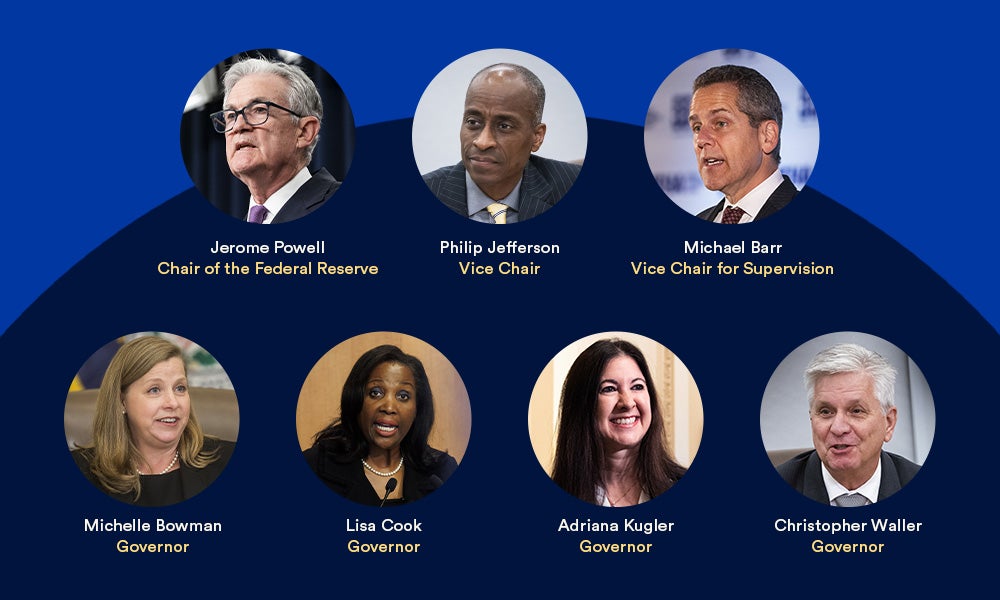
The Fed’s board has seven governors, including the chair and two vice chairs:
- Jerome Powell, chair
- Philip Jefferson, vice chair
- Michael Barr, vice chair for supervision
- Michelle Bowman, governor
- Lisa Cook, governor
- Adriana Kugler, governor
- Christopher Waller, governor
What are the specific responsibilities of the Fed’s board of governors?
Each of the seven governors plays a different role within the U.S. central bank’s board. As Fed chair, Powell guides the broader FOMC to a consensus during rate-setting meetings and then represents that body of officials later on in public appearances and press conferences. He also reports to Congress for mandated testimonies twice a year.
Meanwhile, Vice Chair for Supervision Barr is fulfilling a position that came to fruition under the Dodd-Frank Act of 2010. He serves as the key overseer of the Fed’s regulatory duties and develops policy recommendations regarding how the nation’s financial institutions should be supervised. Examples of such rules include proposing banks’ reserve requirements and implementing bank stress tests.
But responses to economic disasters — such as the coronavirus pandemic from March 2020 and the bank failures from March 2023 — highlight what may be the most powerful role of all for the Fed’s board. Under section 13(3) of the Federal Reserve Act, the Fed can create special vehicles that it then pours money into for the purpose of buying debt, helping to prop up financial markets and keep credit flowing in the broader economy.
The Fed created more than a dozen different programs during the COVID-19 crisis to lend money to hard-hit states, municipalities and even corporations. Its Bank Term Funding Program (BTFP), meanwhile, lent cash to banks in need of liquidity after a wave of bank failures last March.
Those special programs require five affirmative votes among Fed board members to establish, rather than a majority FOMC approval.
Who appoints members of the Fed’s board?
As is the same for the rest of the Fed, officials operate independent from government, but they’re not independent of government. The Fed’s board reports directly to Congress, from which the U.S. central bank derives its direct authority.
Members of the board must first be nominated by the president, questioned and approved by the Senate Banking Committee and then confirmed by the broader U.S. Senate before coming to the Fed.
As for the current officials on the Fed’s board, Powell was initially elevated to Fed chair by President Donald Trump, then later reappointed to another four-year term by President Joe Biden.
Waller and Bowman are the only other Trump-appointees of the board, while Vice Chair Jefferson, Vice Chair for Supervision Barr, Cook and Kugler all came to the post under nominations from Biden.
How long do they serve on the board?
How long a governor serves in his or her position is complicated, but that’s not without reason.
Governors are appointed for 14-year terms, which are staggered and expire on Jan. 31 of every year that ends in an even number. That’s supposed to insulate the Fed from political influence, preventing presidents from single-handedly “stacking the board” with their preferences, according to the St. Louis Fed.
Once a governor has fulfilled a term for 14 years, he or she cannot be reappointed. But if they’re fulfilling an unexpired term, as is the case for Barr and Jefferson, they can be reappointed for another 14 years, opening up the possibility that those officials stay on the Fed for longer.
| Fed board member | Term ending |
|---|---|
| *Filling unexpired term, so could be reappointed Source: Fed’s board of governors |
|
| Jerome Powell, chair | January 31, 2028 |
| Philip Jefferson, vice chair | January 31, 2036* |
| Michael Barr, vice chair for supervision | January 31, 2032* |
| Michelle Bowman, governor | January 31, 2034 |
| Lisa Cook, governor | January 31, 2038 |
| Adriana Kugler, governor | January 31, 2026* |
| Christopher Waller, governor | January 31, 2030* |
The chair and two vice chairs must be reappointed and confirmed every four years. But even if those officials aren’t confirmed, they could technically still choose to stay for the rest of their tenure as a governor.
What authority do they have over other Fed officials?
Mainly, the Fed’s board of governors has a bigger influence than the 12 reserve bank presidents because those officials have a permanent vote on rate decisions, rather than following a three-year rotating schedule (though the New York Fed also has a permanent vote). They also make up the majority of votes (7 of 12) on the FOMC.
How does the Fed’s board ensure that consumers and communities’ concerns are heard at the U.S. central bank?
Congress arranged the Fed System with the diversity of the U.S. economy in mind. The 12 regional reserve banks are supposed to voice the concerns of consumers and businesses throughout their districts in wider rate-setting meetings; yet, the board is also supposed to be diverse, with a member referencing a different Fed district. According to the Federal Reserve Act, they’re supposed to fairly represent U.S. financial, agriculture, industrial and commercial interests. They’re also expected to act nonpartisan and base their arguments on objective economic data.
Congress also mandated that at least one governor has experience in community banking, a position that Bowman is currently occupying.
A 2019-2020 framework review of the Fed’s policies under Powell also inspired Fed governors to host a series of “Fed Listens” events, where policymakers speak with business owners and community members about the economic barriers impacting them most.
What other responsibilities does the board have?
Most of the board’s other responsibilities have to do with its role as an overseer of both financial institutions and the 12 reserve banks. Those jobs include:
- Approving the annual budgets, expenditures and operations of reserve banks, which includes how much each reserve bank president is paid and the regional Fed banks’ individual discount rates;
- Approving who is chosen as a reserve bank president and appointing three of the nine directors of each reserve bank (which are part of a committee that selects the nominee for each regional bank’s president);
- Evaluating and examining financial institutions for their financial soundness, which includes administering stress tests and enforcement actions;
- Publishing broader macroeconomic indicators, such as information on industrial production and the Survey of Consumer Finances (SCF) published every three years.
Bottom line
The board might as well be considered the core of the Fed system, responsible for making sure all of its moving parts are functioning smoothly and orderly — and that the country as a whole is being steered toward the Fed’s broader goals of stable prices, maximum employment and financial stability.
You may also like
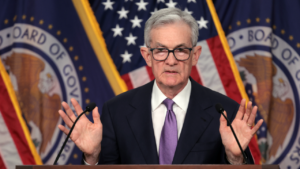
Fed lowers interest rates with surprising jumbo half-point cut
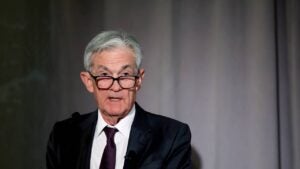
Biggest winners and losers from the Fed’s latest meeting




